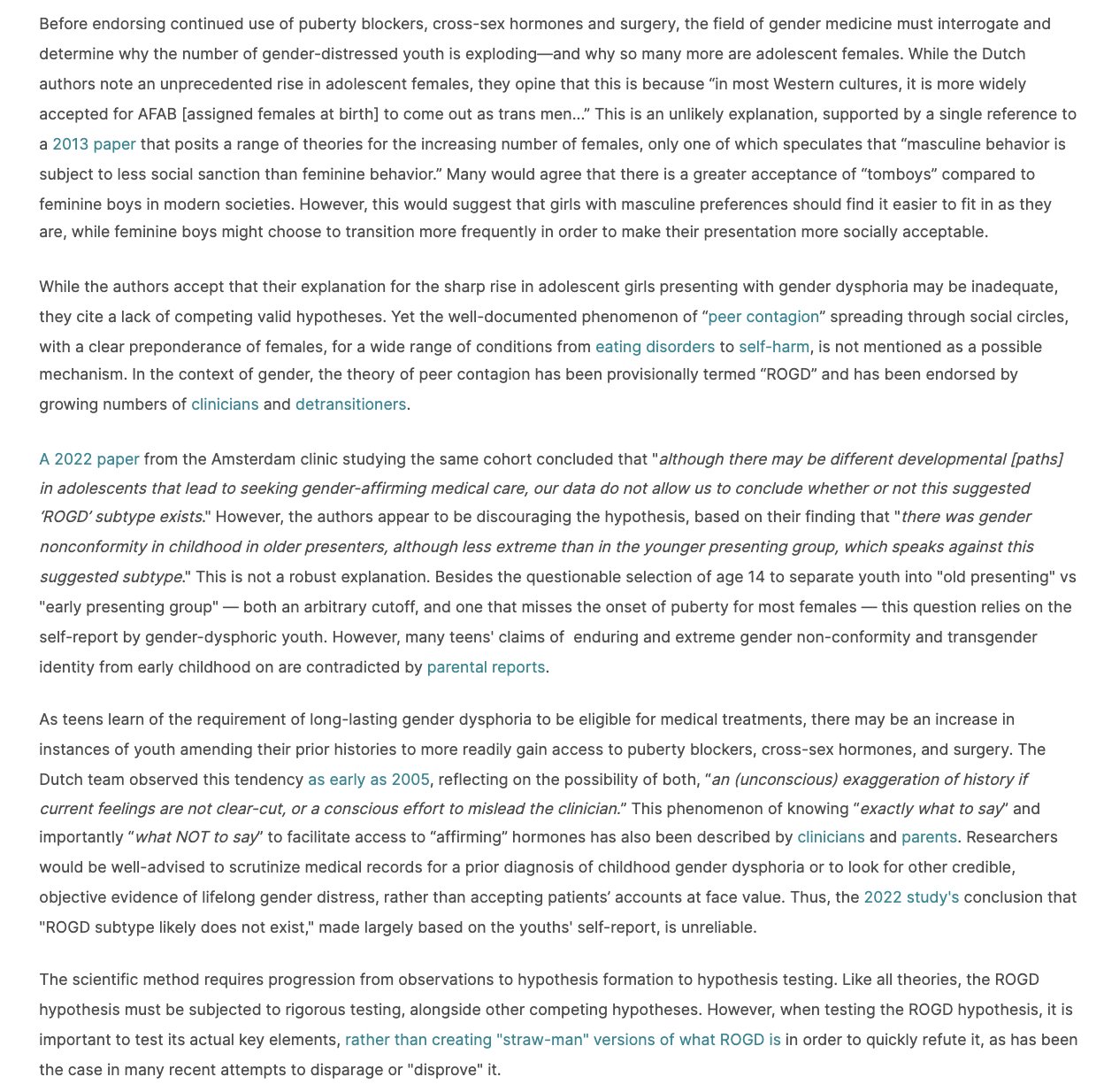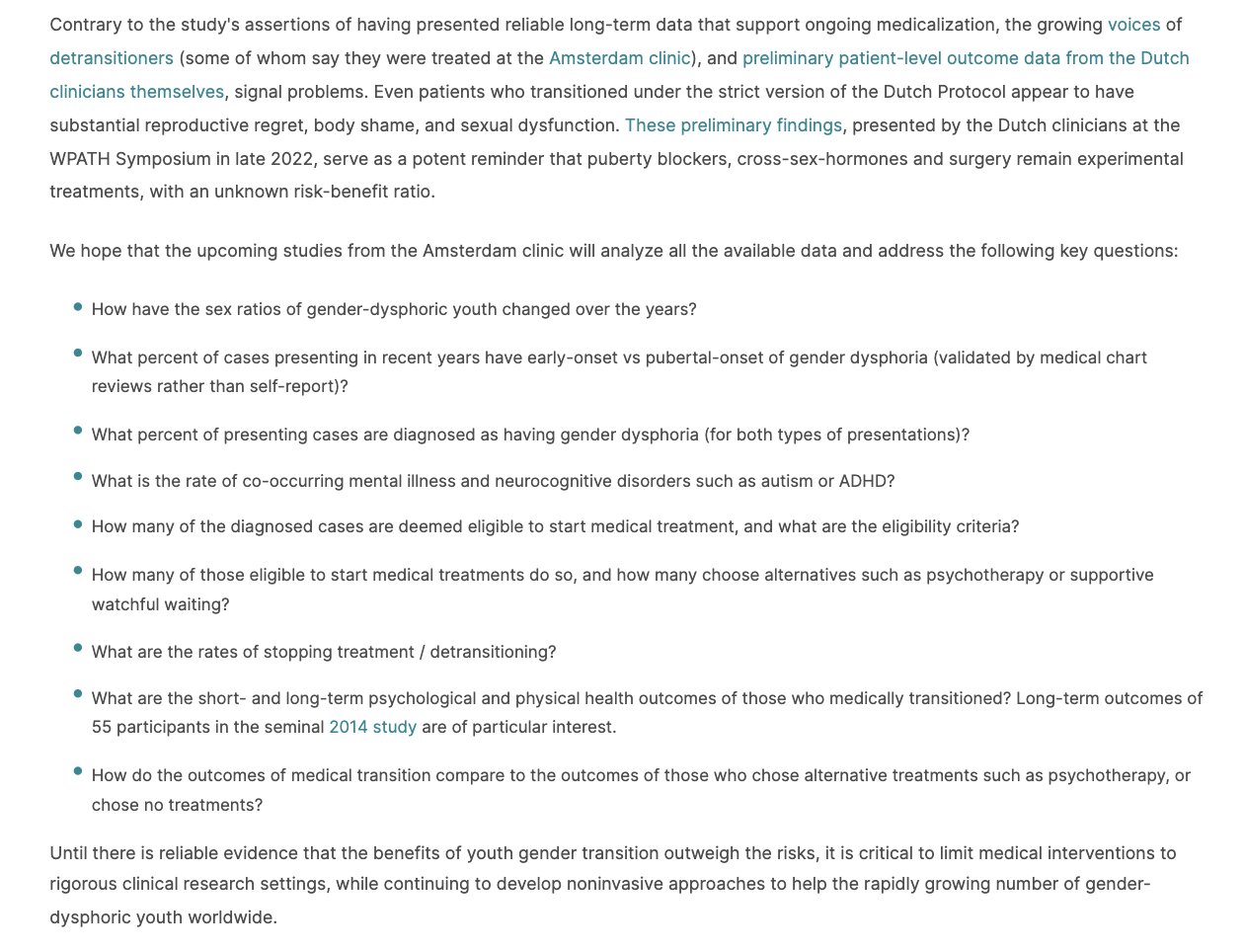Thread
A new study from Amsterdam’s gender clinic finds that puberty blockers may predispose gender-dysphoric children toward eventual full gender transition.
SEGM's analysis of the study is below. /1
segm.org/20-years-of-the-Dutch-Protocol-critical-analysis
SEGM's analysis of the study is below. /1
segm.org/20-years-of-the-Dutch-Protocol-critical-analysis
The study accurately reported the following:
-A sharp increase in recent referrals driven by adolescent females
-A flip in the sex ratios toward females (among older adolescents only)
-Extremely high rate of conversion from puberty blockers to cross-sex hormones (93%-98%). /2
-A sharp increase in recent referrals driven by adolescent females
-A flip in the sex ratios toward females (among older adolescents only)
-Extremely high rate of conversion from puberty blockers to cross-sex hormones (93%-98%). /2
The study authors concede that puberty blockers may not serve as a diagnostic tool as previously thought, but instead are the first step in a medical transition pathway. They also hypothesize that starting puberty blockers may in fact necessitate future gender transition. /3
Unfortunately the study makes several unsupported claims:
- Many “trans youth” don’t get medicalized
- Detransition is extremely rare
- Over 20 years’ worth of outcome data supports continued use of puberty blockers, hormones and surgery in youth.
The data do not support this/4
- Many “trans youth” don’t get medicalized
- Detransition is extremely rare
- Over 20 years’ worth of outcome data supports continued use of puberty blockers, hormones and surgery in youth.
The data do not support this/4
A close read of the study reveals:
1. Most gender-dysphoric teens were medicalized;
2. The rate of detransition was never assessed;
3. Patient-level follow-up was only 4.6 years from intake (and even less from start of treatment) - not 20 years claimed in the title. /5
1. Most gender-dysphoric teens were medicalized;
2. The rate of detransition was never assessed;
3. Patient-level follow-up was only 4.6 years from intake (and even less from start of treatment) - not 20 years claimed in the title. /5
Several other notable facts include:
•Females were more likely than males to medically transition (both early & late-presenting cases)
•Sterilizing surgeries became less frequent after the change in laws in 2014, but were still pursued by a significant number of cases
/6
•Females were more likely than males to medically transition (both early & late-presenting cases)
•Sterilizing surgeries became less frequent after the change in laws in 2014, but were still pursued by a significant number of cases
/6
The study also makes it clear that the Dutch Protocol’s key criteria have not been enforced in the Amsterdam clinic for a number of years. The authors refer to these deviations as an “evolving practice.” /7
The authors note that recent referrals are primarily adolescent females, but they shun suggesting the possible role of “ROGD.”
The ROGD hypothesis has been endorsed by both detransitioners and clinicians caring for gender-dysphoric youth. /8
The ROGD hypothesis has been endorsed by both detransitioners and clinicians caring for gender-dysphoric youth. /8
The investigators from Amsterdam’s gender clinic concluded that 20 years’ worth of data lend support to medical transition in "comprehensively assessed” adolescents. However, the data presented in the study don't support this conclusion. /9
The growing number of detransitioners (including some from the Amsterdam clinic) and sharply increased referrals demand urgent attention to the question: Why are so many young people struggling with gender dysphoria? How do we best care for gender-dysphoric youth? /10
Unfortunately, the study from the home of the Dutch Protocol, which gave rise to the practice of pediatric transitions worldwide, leaves many critical questions unanswered. /end
academic.oup.com/jsm/advance-article/doi/10.1093/jsxmed/qdac029/7005631
academic.oup.com/jsm/advance-article/doi/10.1093/jsxmed/qdac029/7005631



